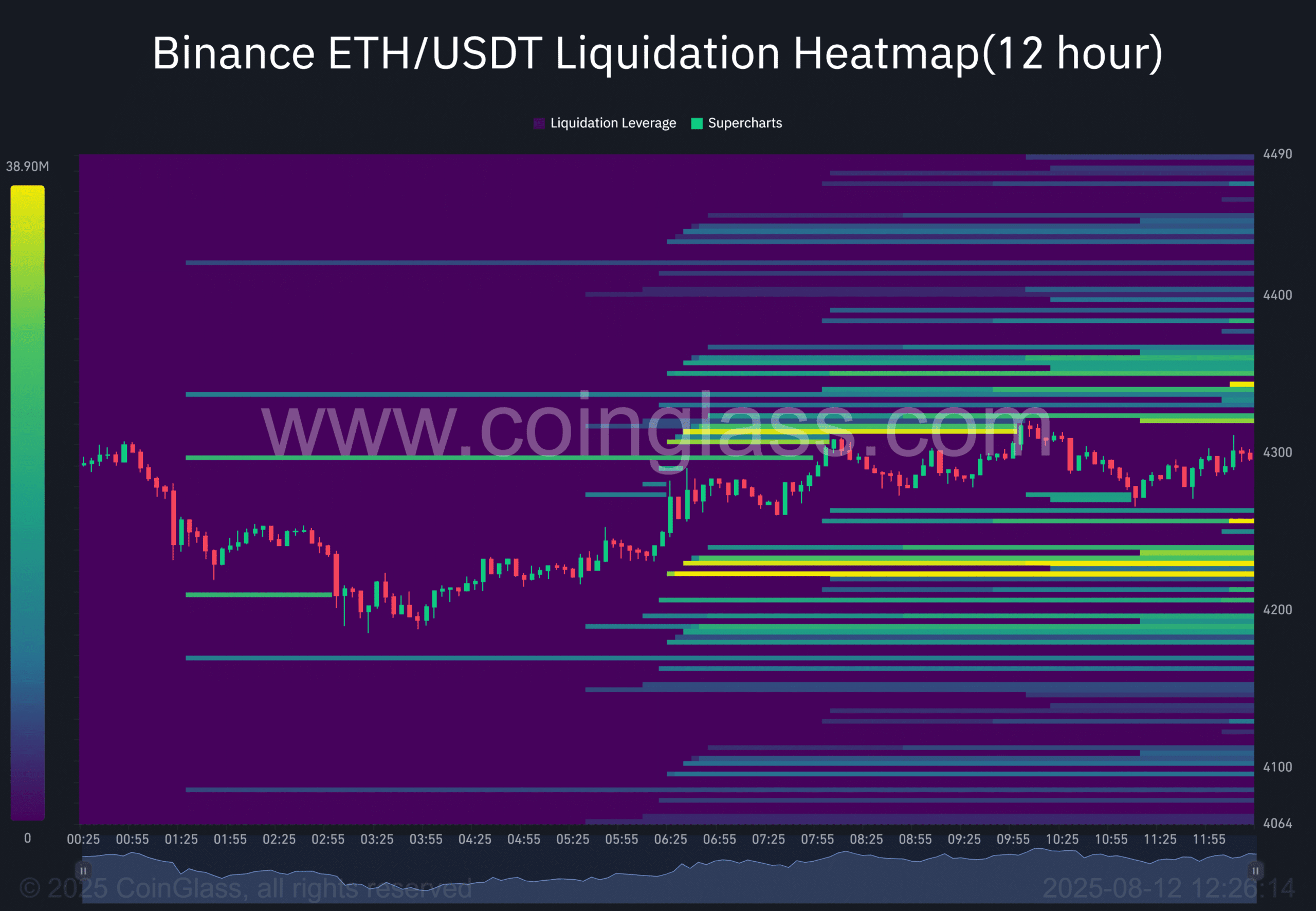
Ethereum has just recorded the cleanest squeeze in months, leading many investors to question whether the 1.32 billion USD short position stuck at 4,700 USD could ignite a fierce breakout if institutions continue to engage.
The recent strong increase has brought Ethereum close to a short-term peak, with large cash inflows from institutions and short derivatives exceeding 60%, creating significant tension in the upcoming trend.
MAIN CONTENT
Ethereum rose 21.45% in the first week of August, showing signs of profit-taking after hitting 4,200 USD and volatility in Open Interest.
Large capital inflows from ETF funds, especially BlackRock, continue to maintain institutional buying momentum in the market.
Over 1.32 billion USD in short positions at 4,700 USD could trigger a strong breakout if the bulls take advantage of liquidity and short pressure.
What has Ethereum just experienced in the cleanest squeeze in months?
Ethereum just witnessed the cleanest squeeze in the derivatives market - when short positions were pushed into a difficult situation by an unexpected price increase, forcing many investors to buy to cover losses, contributing to increased volatility and pushing the price higher.
Ethereum just recorded the largest squeeze in six months, setting the stage for a breakout if institutional capital continues to flow strongly into the market.
Glassnode Insights, 08/2025, source: glassnode.com
This squeeze process occurs when the volume of short positions in the derivatives market is concentrated at a price point, leading to a wave of forced short closures after a strong price increase. This often triggers a wave of Fear of Missing Out (FOMO), causing many investors to jump in to buy, pushing the price of ETH even higher.
In the context of the market lacking liquidity and institutional cash continuously pouring in through ETF channels, a large squeeze occurring right after ETH reaches a realized profit peak exceeding 1 billion USD creates a clear fear of missing out and places remaining short positions in danger.
Is Ethereum signaling a short-term peak?
After rising to 21.45% in the first week of August, many indicators argue that Ethereum may create a short-term peak, especially as on-chain data records strong profit-taking at around 4,200 USD.
According to TradingView data, ETH only took seven days to rise over 20%, marking a rare vertical increase. However, history shows that such rapid increases often lead to corrections when investors take profits, reduce leverage, or sentiment in the market becomes cautiously short-term.
Specifically, from August 4 to 10, ETH continuously surged, pushing the RSI index close to 70, but still did not exceed the 80 mark like at the previous peak in July (when ETH was at 3,941 USD). This indicates that the upward momentum has not yet entered the extreme overbought zone, allowing the bulls to maintain hopes for another upward movement before a correction.
Although the staking amount slightly decreased after peaking at 36.23 million ETH, institutional cash flows and trading volumes still support the upward trend.
CryptoQuant On-chain Report, 08/2025
However, the volume of staking dropped by 60,000 ETH in just 5 days, implying that some large investors have begun to choose to cash out profits. Nevertheless, the bulls still hold an advantage as institutional ETF cash flows set new records for inflows.
Is strong institutional ETF cash flow supporting Ethereum's price?
Institutional ETF cash flows continue to play a key role in sustaining ETH's upward momentum even when the market shows signs of profit-taking and increasing short derivatives.
BlackRock's Ethereum ETF recorded a net inflow of 640 million USD in just one day, a record that helps ETH maintain significant buying pressure from global institutional investors.
Farside Investors, 08/2025, farside.co.uk
In addition to BlackRock (with the ETHA ETF Fund), other ETF cash flows contributed a total of 1.08 billion USD to Ethereum in the past week, bringing total institutional buying to its highest level since 2021.
In fact, this momentum, along with the prolonged increase after a large squeeze, has caused the short skew - the ratio of short positions exceeding 60% - not to crash the price of ETH; instead, it has increased the pressure to reverse for the shorts, creating conditions for a potential breakout scenario at important resistance zones.
What is happening in the Ethereum derivatives market?
Currently, ETH's derivatives market is witnessing a significant short-long position gap, with over 60% skewed towards shorts. This means most derivative investors are betting on a price correction after a strong upward movement.

The Open Interest volume has tightened by 3% amid strong profit-taking, but total short outstanding still stands at 1.32 billion USD concentrated around the 4,700 USD price zone. This is a threshold that, if surpassed, many short positions will have to 'cut losses', creating a domino effect of ‘explosion closures’ for the market.
Additionally, large liquidity flows at 4,344 USD with 36 million USD short being 'trapped' are strongly reinforcing the upper resistance band by investors hoping for a short-term price reversal. However, if prices continue to be driven by cash flows and squeezes, this area will quickly become a strong breakout launch pad.
August 2025 Index Factors Historical Comparison ETH price increase of +21.45% in 1 week Highest since early 2022 Realized Profit of 1 billion USD at 4,200 USD Largest since ATH 2021 Staking volume dropped -60,000 ETH after 5 days Average drop < 30,000 ETH/week Net inflow from institutional ETFs 1.08 billion USD, with BlackRock alone 640 million USD/day Historic high according to Farside.co.uk Short derivatives outstanding of 1.32 billion USD at 4,700 USD High “short squeeze” warning level
How is ETH liquidity pressure evolving?
The liquidity of ETH on exchanges continues to tighten as the amount of ETH stored on exchanges decreases by 170,000 ETH, corresponding to a significant trend of transferring ETH to safe wallets or long-term staking.
The outflow of ETH from exchanges signals the flow of assets into the hands of medium-long term holders, narrowing exchange liquidity and strengthening the uptrend cycle.
CryptoQuant Exchange Flows, 08/2025
Specifically, the amount of ETH reserves on exchanges has sharply decreased right after profit-taking surged, combined with a sudden unstaking flow, signaling that the market is re-accumulating a balanced liquidity state.
The large liquidity threshold at 4,344 USD becomes an important psychological testing ground, where shorts and longs may 'collide', deciding the next price direction before the critical 4,700 USD threshold.
Can Ethereum break 5,000 USD before Q3?
The scenario of breaking 5,000 USD before Q3 has a high probability of occurring if institutional capital flows remain strong, liquidity continues to tighten, and shorts are forced to flee from the 4,700 USD area.
If ETF cash flows maintain this pace and the squeeze event continues, breaking through 5,000 USD is completely within Ethereum's reach.
AMBCrypto Strategy Report, 08/2025
In fact, with institutional buying pressure concentrated near resistance areas, combined with a large amount of short derivatives, ETH could completely see a breakout - especially as many whales are also surprisingly impressed with the current capital flow strength.
Moreover, the 'FOMO' event when prices exceed historical peaks will cause many traders to change strategies from short to long, creating a domino effect explosion that drives the continued upward trend.
What does the current health of the ETH market indicate?
Aggregated data shows that the ETH ecosystem is operating healthily, with the RSI indicator fluctuating around 70, not yet entering the exhaustion phase, meaning the upward momentum still has room to continue.
On-chain data such as Realized Profit, Net Staking, and Exchange Reserve all indicate that large cash flows are concentrating, a positive signal for the potential to continue a strong upward trend in the next 1-2 months if there are no major unexpected fluctuations from outside the cryptocurrency ecosystem.
However, risks still arise from the large volume of short derivatives, meaning if institutional capital flows suddenly withdraw, the shorts will have a chance to 'flip the script' very quickly, creating strong volatility in a short time.
What challenges and opportunities await Ethereum?
The strong increase of ETH in the first half of August opens up opportunities to conquer historical resistance levels, but at the same time hides many significant challenges, from profit-taking pressure, short squeeze effects to unexpected ‘trade explosions’ from whale investors.
The steady flow of institutional capital and the large amount of short derivatives puts ETH at risk of an unexpected ‘wave run’, while also being a bottleneck if sellers gain the upper hand when the market experiences macro volatility or unfavorable policies.
The current ETH market is like an extremely tight string – every move from institutions and large holders can trigger unexpected volatility/unpredictable price directions in the short term.
Source: AMBCrypto Analysis, 08/2025
Despite existing risks, ETH remains the focal point attracting institutional investment capital throughout 2025, laying the groundwork for all optimistic projections about a sustainable growth cycle if all indicators hold steady.
What is the difference between the current pump and previous price increases of ETH?
This pump is different due to the leading role of institutional ETF cash flows, rather than just relying on market leaders' FOMO and retail investors as in previous years.
The Realized Profit index is 1 billion USD, net ETF inflow over 1 billion USD, along with strong derivative leverage helping to sustain the upward momentum - in contrast to previous pump-and-dump phases that often reversed quickly.
Additionally, both staking and exchange reserve ratios have adjusted slightly, with no panic selling phenomenon occurring, indicating stability and the confidence of medium-long term holders is still very strong.
What lessons can ETH investors learn during this phase?
Investors should pay attention to coordinate on-chain indicators, ETF flow changes, and derivatives momentum to determine reasonable entry and exit points, avoiding FOMO or 'catching the top' when a short squeeze could occur at any time.
Prioritizing risk management, placing stop-loss orders at significant resistance or support levels, and continuously monitoring ETF cash flows will help minimize losses if the market suddenly reverses.
Every trading decision should be based on a comprehensive analysis of many aspects - not just looking at the current price, but also analyzing the macro context, institutional money flow, short squeeze, and liquidity state.
Frequently Asked Questions about the current Ethereum trend
Ethereum has just surpassed the 4,200 USD mark; what has driven this strong increase?
The main momentum comes from large cash flows from institutional ETF funds like BlackRock, along with the squeezing of short positions in the derivatives market.
What does a short derivatives ratio over 60% mean for ETH?
It shows that many traders are betting on a price decrease, but it also increases the risk of a squeeze - when prices rise, they are forced to buy back, further pushing prices higher.
Do the staking and exchange reserve flows indicate a major correction is imminent?
Staking volume has decreased but exchange reserves have also decreased, indicating that ETH is being redistributed to strong holders, not signaling panic selling or excessive fear.
Is the short position of over 1.32 billion USD at 4,700 USD vulnerable to a squeeze?
It's very easy; as soon as the price goes above 4,700 USD, the pressure to cut losses will explode strongly, making a large breakout entirely possible.
How to manage risks when ETH fluctuates sharply?
Investors should use stop-loss orders, closely monitor ETF cash flows, and derivatives volumes to avoid being swept into unexpected FOMO or short squeezes.
Can ETH surpass 5,000 USD before Q3?
This scenario is plausible if institutional cash flows maintain as they are now and the shorts have to flee from the 4,700 USD resistance.
What are the main risks to watch in the ETH market?
It's the volatility of short derivatives, institutional cash flow, and macro factors that could cause holders or shorts to make large-scale trades, creating unexpected volatility.
Source: https://tintucbitcoin.com/ethereum-khi-nao-dat-dinh-moi/
Thank you for reading this article!
Please Like, Comment and Follow TinTucBitcoin to always stay updated on the latest news about the cryptocurrency market and not miss any important information!

